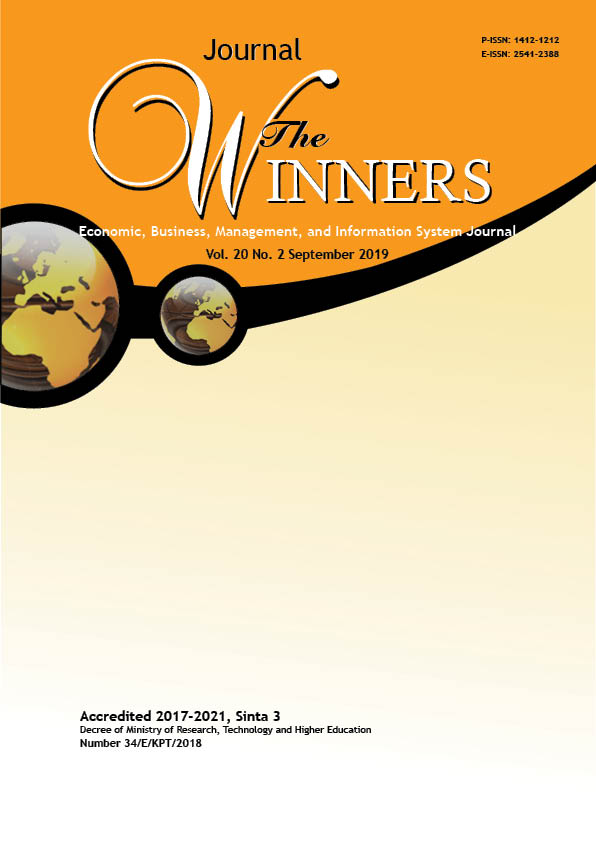Information System Strategic Planning at PT EP-TEC Solutions Indonesia
DOI:
https://doi.org/10.21512/tw.v20i2.5773Keywords:
Strategic Planning Information Systems, Ward and Peppard, SWOT Analysis, IT Balance Scorecard, Application PortfolioAbstract
This research aimed to analyze the internal and external environment of business and information system /information technology (IS/IT), to identify current and future application portfolios, and to develop an Information System Strategic Planning to achieve the vision, mission, and objectives of PT EP-TEC Solutions Indonesia. The data were obtained from the results of interviews, observations, literature study, questionnaires, and analysis of the company’s internal documents. Data were taken from interviewing and questionnaires that were ten managerial levels of 50 employees at PT EP-TEC Solutions Indonesia. The weight on the SWOT IFAS and EFAS matrix used a pairwise comparison method. The method applied descriptive method by using the Information System Strategic Planning framework from Ward and Peppard. The analytical tools used Porter’s Five Forces, PEST, SWOT, Value Chain, IT Balance Scorecard, and McFarlan Strategic Grid. The results of this research indicate that future application portfolio recommendation that supports SI business strategies, IS/IT management strategies, and IT strategies that can help PT EP-TEC Solutions Indonesia in achieving strategic goals. From these results, it can be concluded that there are several proposals for applications, security tools, profiles of knowledge and skills, and recommendations for IS/IT infrastructure that can be applied in the company.
References
Al-aboud, F. N. (2011). Strategic information systems planning: A brief review. IJCSNS International Journal of Computer Science and Network Security, 11(5), 179–183. Retrieved from http://paper.ijcsns.org/07_book/201105/20110526.pdf.
Babafemi, I. D. (2015). Corporate strategy, planning, and performance evaluation: A survey of literature. Journal of Management Policies and Practices, 3(1), 43-49. https://doi.org/10.15640/jmpp.v3n1a6
David, F. R. (2011). Strategic management concepts: A competitive advantage approach. New Jersey: Pearson College.
Holt, C., & Wolff, T. (2015). The community tool box, a comprehensive tool and a sample of what you will find there: Community assessment methods - conducting a SWOT analysis. Global Journal of Community Psychology Practice, 6(1), 4–7.
Khani, N., Nor, K. M., & Bahrami, M. (2011). IS/IT capability and strategic information system planning (SISP) success. International Management Review, 7(2), 75–83.
O’Brein, J. (2006). Pengantar sistem informasi: Perspektif bisnis dan manajerial (12th ed.). Jakarta: Salemba Empat.
Peppard, J., & Ward, J. (2016). The strategic management of information systems: Building a digital strategy. New Jersye: Wiley.
Sampurna, A. L., Darmawan, A., & Nugroho, H. W. (2015). The usage of Ward and Peppard method in IS/IT strategic plan compilation in Dishubkominfo East Lampung. In International Conference On Information Technology And Business. Lampung, Indonesia. pp 205–212.
Swierk, J., & Mulawa, M. (2014). IT balanced scorecard as a significant component of competitive and modern company. In Management, Knowledge, and Learning International Conference. Portoroz, Slovenia. pp 821-829.
Downloads
Published
How to Cite
Issue
Section
License
Authors who publish with this journal agree to the following terms:
a. Authors retain copyright and grant the journal right of first publication with the work simultaneously licensed under a Creative Commons Attribution License - Share Alike that allows others to share the work with an acknowledgment of the work's authorship and initial publication in this journal.
b. Authors are able to enter into separate, additional contractual arrangements for the non-exclusive distribution of the journal's published version of the work (e.g., post it to an institutional repository or publish it in a book), with an acknowledgment of its initial publication in this journal.
c. Authors are permitted and encouraged to post their work online (e.g., in institutional repositories or on their website) prior to and during the submission process, as it can lead to productive exchanges, as well as earlier and greater citation of published work.
USER RIGHTS
All articles published Open Access will be immediately and permanently free for everyone to read and download. We are continuously working with our author communities to select the best choice of license options, currently being defined for this journal as follows: Creative Commons Attribution-Share Alike (CC BY-SA)

















